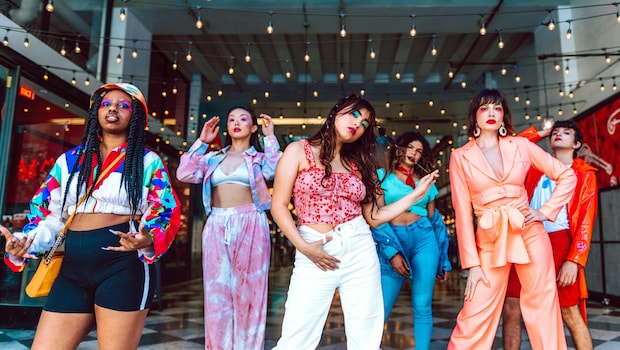Introduction to Indie Sleaze Nostalgia
Gen Z, born between 1997 and 2012, is chasing a vibe they never fully experienced—a gritty, carefree aesthetic from the late 2000s and early 2010s called “indie sleaze.” Think smudged eyeliner, skinny jeans, and grainy photos snapped at sweaty club nights. This nostalgia, oddly enough, isn’t for their own childhoods but for a pre-social media era they romanticize as raw and unfiltered.
What is Indie Sleaze?
Defining the Aesthetic
Indie sleaze is a cultural snapshot of the mid-to-late 2000s and early 2010s, marked by a messy, hedonistic vibe. It’s Kate Moss in denim cut-offs at Glastonbury, Amy Winehouse’s winged eyeliner, and The Libertines’ raw guitar riffs. The term, coined in 2021 by an Instagram account (@indiesleaze), captures a party scene that “died in 2012,” per its bio.
Origins of the Movement
The roots trace back to New York’s early 2000s indie rock scene—think The Strokes and Yeah Yeah Yeahs—before spreading to London’s Camden clubs. It blended post-grunge rebellion with a DIY ethos, fueled by digital cameras and Myspace. Fashion leaned into vintage tees, studded jackets, and an effortlessly disheveled look.
Why Gen Z is Drawn to Indie Sleaze
Escaping a Polished Digital World
Gen Z grew up under the glossy filter of Instagram and TikTok, where perfection is curated to death. Indie sleaze, with its unpolished, almost chaotic energy, feels like a rebellion against today’s hyper-edited reality. It’s a middle finger to algorithm-driven aesthetics, offering a gritty authenticity they crave.
Nostalgia for a Pre-Social Media Era
Most of Gen Z was too young to hit the clubs during indie sleaze’s peak (2006–2012). Yet, they’re nostalgic for a time when life wasn’t documented every second. The era’s blurry, flash-heavy photos evoke a sense of freedom—parties without performative posts, where mistakes didn’t go viral.
Economic and Social Turmoil
Economic uncertainty and post-pandemic burnout hit Gen Z hard. A 2022 study found 42% of Gen Z adults face mental health challenges, often tied to social media’s pressures. Indie sleaze, with its carefree hedonism, offers an escapist fantasy—a time when the world seemed less heavy, even if it wasn’t.
The Aesthetic Appeal of Indie Sleaze
Fashion: Messy, Bold, and Unapologetic
Indie sleaze fashion is a love letter to imperfection. Gen Z is raiding thrift stores for faded band tees, skinny jeans, and leather jackets—items that scream “I don’t care, but I look cool.” Designers like Isabel Marant, whose wedge sneakers defined the era, are seeing a resurgence among Gen Z buyers.
Music: Raw and Rebellious
The soundtrack of indie sleaze—think Arctic Monkeys’ Whatever People Say I Am, That’s What I’m Not (2006) or Amy Winehouse’s Back to Black (2006)—is gritty and unpolished. Gen Z streams these albums on Spotify, drawn to their raw energy. Modern artists like Charli XCX and The Dare echo this vibe, blending nostalgia with fresh spins.
Visuals: Grainy and Unfiltered
The aesthetic thrives on low-fi visuals—think disposable camera shots with harsh flash. TikTok is flooded with tutorials mimicking this look, from smudged makeup to retro filters. It’s a stark contrast to today’s ultra-HD, AI-enhanced content, making it feel refreshingly real.
The Role of Social Media in the Revival
TikTok as a Nostalgia Machine
TikTok has been a catalyst, with millions of views on #indiesleaze videos. Gen Z creators recreate the era’s makeup (heavy eyeliner, no contour) and outfits (ripped tights, oversized scarves). These posts aren’t just trends—they’re a collective yearning for a less curated past.
Instagram’s Role in Rediscovery
The @indiesleaze Instagram account, run by a Toronto creator, curates iconic images of the era—Kate Moss at festivals, Sky Ferreira in smoky clubs. It’s a digital museum for Gen Z, who weren’t there but feel the pull of its raw energy. This account sparked the term and fueled the revival.
The Dark Side of Indie Sleaze
Romanticizing a Troubled Era
While Gen Z sees indie sleaze as a “cool time to be alive,” it wasn’t all glitter and guitar riffs. The era was marked by toxic diet culture, casual misogyny, and unchecked substance abuse. Amy Winehouse’s struggles, for instance, were glamorized by tabloids, a reality Gen Z often overlooks.
The Plight of Women in the Scene
Kate Nash’s podcast, The Rise and Fall of Indie Sleaze, highlights the era’s darker side, especially for women. Female artists faced relentless scrutiny over their bodies and behavior, with tabloids like The Sun amplifying misogyny. Gen Z’s rose-tinted view risks ignoring these harsh realities.
Comparison: Indie Sleaze vs. Modern Trends
| Aspect | Indie Sleaze (2006–2012) | Modern Gen Z Trends (2025) |
|---|---|---|
| Fashion | Skinny jeans, vintage tees, studded jackets | Y2K-inspired low-rise jeans, minimalist athleisure |
| Music | Raw indie rock (The Libertines, Arctic Monkeys) | Polished pop, lo-fi hip-hop |
| Photography | Grainy, flash-heavy disposable camera shots | High-definition, AI-filtered Instagram posts |
| Cultural Vibe | Carefree hedonism, DIY ethos | Curated authenticity, social awareness |
Why Nostalgia Resonates with Gen Z
Psychological Comfort in Familiarity
Nostalgia is a coping mechanism. A 2022 Journal of Neuroscience study found it reduces perceived pain, acting as self-care. For Gen Z, facing burnout (58% report it) and a loneliness epidemic, indie sleaze’s messy charm feels like a warm, familiar hug.
Seeking Shared Cultural Touchstones
Unlike past generations, Gen Z lacks unifying cultural moments due to fragmented media. Indie sleaze offers a shared aesthetic they can rally around, from rewatching Skins to thrifting 2000s-era clothes. It’s a way to connect in a disconnected world.
Pros and Cons of Indie Sleaze Nostalgia
Pros:
- Encourages creativity through DIY fashion and music.
- Offers an escape from polished, algorithm-driven culture.
- Fosters community through shared nostalgia on platforms like TikTok.
Cons:
- Risks glamorizing toxic behaviors like substance abuse.
- Ignores the era’s misogyny and body-shaming culture.
- May distract from creating new, authentic trends.
How Gen Z is Reviving Indie Sleaze
Fashion Resurgence
Thrift stores and resale platforms like Depop are goldmines for Gen Z seeking indie sleaze staples. Isabel Marant’s wedge sneakers, once worn by Beyoncé, are hot again, with searches spiking on Vestiaire Collective. Gen Z’s love for vintage aligns with their sustainability values.
Music and Media Influence
Spotify playlists titled “Indie Sleaze Bangers” are trending, featuring The Kooks, Interpol, and LCD Soundsystem. Meanwhile, TV shows like Skins and reboots like Gossip Girl feed the vibe. Gen Z isn’t just copying—they’re remixing it with modern flair.
Where to Get Indie Sleaze Looks
- Thrift Stores: Local shops or chains like Goodwill for vintage tees and jackets.
- Resale Platforms: Depop, Poshmark, or Vestiaire Collective for designer pieces like Marant’s sneakers.
- DIY Customization: Distress your own jeans or sew patches for that authentic messy vibe.
- Fast Fashion: H&M or ASOS for affordable skinny jeans and scarves, though prioritize sustainable options.
People Also Ask (PAA)
What is indie sleaze?
Indie sleaze is a cultural aesthetic from the late 2000s to early 2010s, defined by messy fashion (skinny jeans, vintage tees), raw indie rock, and grainy photography. It’s a nostalgic vibe Gen Z loves for its unpolished, carefree energy.
Why is Gen Z obsessed with nostalgia?
Gen Z seeks nostalgia to cope with modern stress—economic woes, social media overload, and loneliness. A 2022 study shows nostalgia reduces pain perception, making past aesthetics like indie sleaze comforting.
How can I recreate the indie sleaze look?
Thrift for faded band tees, skinny jeans, and leather jackets. Add smudged eyeliner and messy hair. Use a disposable camera or retro filter for photos. Check Depop for vintage finds or DIY your own distressed pieces.
Is indie sleaze problematic?
Yes, it can be. The era romanticized toxic behaviors like substance abuse and had a misogynistic edge, especially toward female celebrities. Gen Z’s nostalgia sometimes overlooks these issues, as noted in Kate Nash’s podcast.
FAQ Section
What defines the indie sleaze aesthetic?
It’s a mix of messy fashion (think skinny jeans, studded jackets), raw indie rock, and grainy, flash-heavy photography from the late 2000s to early 2010s. It’s carefree, unpolished, and rebellious.
Why does Gen Z romanticize a time they didn’t live through?
Gen Z craves the pre-social media freedom of indie sleaze, seen as less curated than today’s digital world. Economic and social pressures also push them toward nostalgic escapism.
How can I incorporate indie sleaze into my style?
Start with thrift store finds—vintage tees, skinny jeans, or leather boots. Add bold makeup like smudged eyeliner. Mix high and low fashion, like a designer jacket with DIY-distressed denim.
Are there modern artists inspired by indie sleaze?
Yes, artists like Charli XCX and The Dare channel its raw energy. Their music and style blend indie sleaze’s gritty vibe with modern production, appealing to Gen Z’s nostalgia.
Is the indie sleaze revival sustainable?
The revival leans on thrifting and vintage fashion, which aligns with Gen Z’s eco-conscious values. However, fast fashion knockoffs could undermine this if not balanced with sustainable choices.
Conclusion: Balancing Nostalgia and Reality
Gen Z’s love for indie sleaze is more than a trend—it’s a reaction to a world that feels too polished, too heavy, too connected. They’re chasing a fantasy of freedom, where parties didn’t need filters and imperfections were celebrated. But as Kate Nash reminds us, the era wasn’t all glitter; it had a dark, messy underbelly. By embracing indie sleaze thoughtfully—through sustainable fashion, mindful music choices, and an awareness of its flaws—Gen Z can keep the vibe alive without losing sight of the present. So, dig out those skinny jeans, crank up The Strokes, and let’s party like it’s 2006—just with a little more self-awareness.





